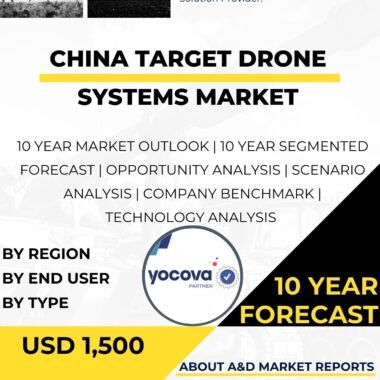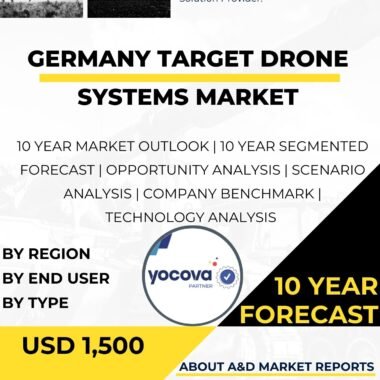Description
Target drone systems are an integral part of the United States military’s training, testing, and evaluation processes, providing realistic and cost-effective means to simulate enemy threats and evaluate the performance of various weapon systems. These unmanned aerial vehicles (UAVs) are specifically designed to mimic the flight characteristics and signatures of enemy aircraft or missiles, enabling the U.S. Armed Forces to hone their combat skills and validate their defensive capabilities in a controlled environment.
The history of target drone systems dates back to the early 20th century, when the U.S. military recognized the need for realistic training scenarios to improve combat readiness. During World War II, the development of radio-controlled target drones provided a means for antiaircraft gunners and fighter pilots to practice engaging moving targets. These early target drones, such as the OQ-2 Radioplane, laid the foundation for the modern target drone systems used today.
As technology advanced, so did the capabilities of target drone systems. The evolution of jet-powered engines allowed for faster and more agile drones, better simulating the performance of modern enemy aircraft. Additionally, the integration of advanced avionics and electronic systems enabled more realistic radar cross-sections, infrared signatures, and electronic warfare capabilities, making target drones even more challenging to detect and engage.
Today, the United States utilizes a diverse range of target drone systems to meet the training and testing needs of various military branches. These target drones vary in size, performance, and complexity, catering to different operational requirements.
One of the most prominent target drone systems used by the U.S. military is the BQM-167 Skeeter, developed by Kratos Defense & Security Solutions. The Skeeter is a high-performance, subsonic aerial target designed to replicate enemy aircraft and missiles. It can fly at speeds exceeding Mach 0.9 and at altitudes up to 50,000 feet, allowing it to simulate a wide range of threat profiles. Its versatility and performance make it an ideal target for training air defense crews and testing weapon systems.
The MQM-178 Firejet, produced by Composite Engineering Inc. (now part of Kratos), is another notable target drone system used by the U.S. military. The Firejet is a supersonic target drone capable of speeds up to Mach 2.0, accurately replicating the flight characteristics of high-speed enemy missiles. Its small size and agility challenge missile defense systems, providing invaluable data for evaluating the performance of missile interceptors.
In addition to aerial target drones, the United States also employs surface and underwater target systems to train naval forces. The QSTAG (Quick Strike Aerial Target) is a subsonic, sea-skimming aerial target designed to simulate anti-ship missiles. Launched from ships or shore, the QSTAG offers realistic training scenarios for naval crews to practice engaging incoming threats.
For underwater training, the GQM-163 Coyote is a supersonic sea-skimming target system, launched from surface ships or submarines. The Coyote simulates enemy anti-ship missiles and torpedoes, providing naval forces with valuable opportunities to refine their defensive tactics and countermeasures.
The deployment of target drone systems is not limited to training and testing alone. These drones also serve as an essential tool for evaluating the performance of various weapon systems and sensors. They enable live-fire exercises, allowing weapon systems to engage realistic threats while collecting valuable data on accuracy, lethality, and engagement dynamics.
Moreover, target drone systems are used in joint training exercises and military drills, allowing different branches of the military to collaborate and practice integrated operations. These joint exercises enhance coordination and interoperability, essential for success in modern warfare.
The role of target drone systems extends beyond conventional warfare training. They play a crucial role in the research and development of new weapon systems and technologies. By serving as realistic targets, these drones assist in testing the effectiveness and capabilities of emerging defense systems, facilitating the refinement and improvement of cutting-edge military hardware.
As the technological landscape continues to evolve, the U.S. military is exploring the integration of artificial intelligence and autonomous capabilities into target drone systems. Autonomous target drones could adapt their flight profiles and behaviors dynamically, enhancing their realism and unpredictability during training scenarios. Additionally, autonomous drones could reduce the demand for skilled operators, making them more cost-effective and accessible for training purposes.
However, the use of target drone systems is not without challenges. Safety is a critical concern, as these drones often fly in close proximity to military personnel and equipment during training exercises. Stringent safety protocols and robust command and control systems are essential to mitigate the risk of accidents and ensure the safe operation of target drones.
In conclusion, target drone systems play a vital role in enhancing the combat readiness and capabilities of the United States military. By accurately simulating enemy threats, these unmanned aerial and underwater vehicles provide realistic training scenarios for troops and allow for the evaluation of weapon systems and sensors. As technology advances, target drone systems will continue to evolve, ensuring that the U.S. Armed Forces remain at the forefront of military training and preparedness.




